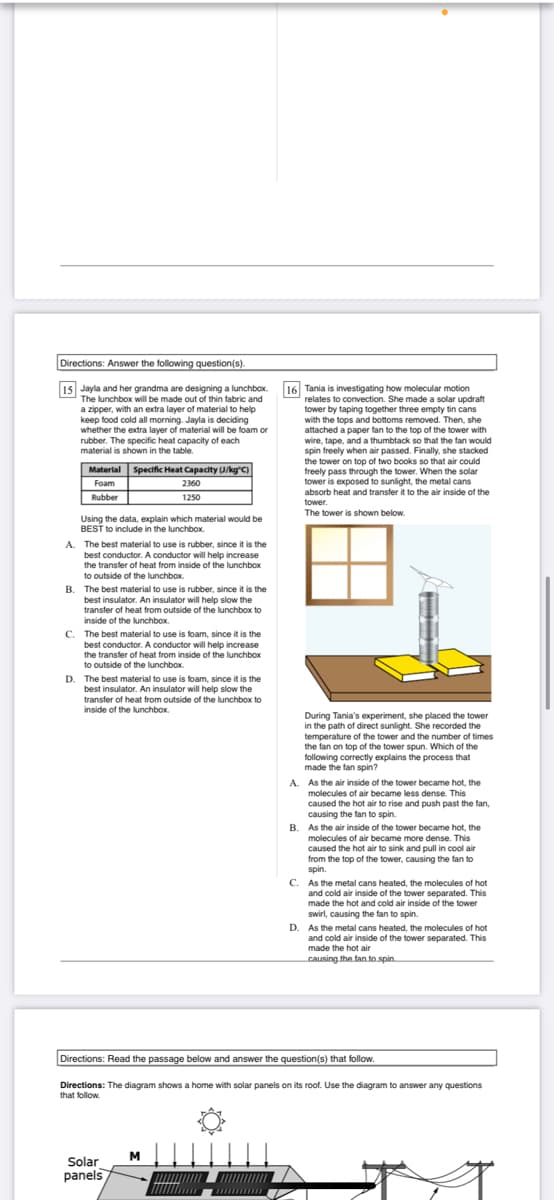Directions: Answer the following question(s). 15 Jayla and her grandma are designing a lunchbox. The lunchbox will be made out of thin fabric and a zipper, with an extra layer of material to help keep tood cold all morning. Jayla is deciding whether the extra layer of material will be foam or rubber. The specific heat capacity of each material is shown in the table. 16 Tania is investigating how molecular motion relates to covection. She made a solar updraft tower by taping together three empty tin cans with the tops and bottoms removed. Then, she attached a paper fan to the top of the tower with wire, tape, and a thumbtack so that the fan would spin freely when air passed. Finally, she stacked the tower on top of two books so that air could freely pass through the tower. When the solar tower is exposed to sunlight, the metal cans absorb heat and transfer it to the air inside of the tower. The tower is shown below. Material Specific Heat Capacity U/kgC) Foam 2360 Rubber 1250 Using the data, explain which material would be BEST to include in the lunchbox. A. The best material to use is rubber, since it is the best conductor. A conductor will help increase the transfer of heat from inside of the lunchbox to outside of the lunchbox. B. The best material to use is rubber, since it is the best insulator. An insulator will help slow the transfer of heat from outside of the lunchbox to inside of the lunchbox. C. The best material to use is foam, since it is the best conductor. A conductor will help increase the transfer of heat from inside of the lunchbox to outside of the lunchbox. D. The best material to use is foam, since it is the best insulator. An insulator will help slow the transfer of heat from outside of the lunchbox to inside of the lunchbox. During Tania's experiment, she placed the tower in the path of direct sunlight. She recorded the temperature of the tower and the number of times the fan on top of the tower spun. Which of the following correctly explains the process that made the fan spin? A. As the air inside of the tower became hot, the molecules of air became less dense. This caused the hot air to rise and push past the fan, causing the fan to spin. B. As the air inside of the tower became hot, the molecules of air became more dense. This caused the hot air to sink and pull in cool air trom the top of the tower, causing the fan to spin. C. As the metal cans heated, the molecules of hot and cold air inside of the tower separated. This made the hot and cold air inside of the tower swirl, causing the fan to spin. D. As the metal cans heated, the molecules of hot
Thermochemistry
Thermochemistry can be considered as a branch of thermodynamics that deals with the connections between warmth, work, and various types of energy, formed because of different synthetic and actual cycles. Thermochemistry describes the energy changes that occur as a result of reactions or chemical changes in a substance.
Exergonic Reaction
The term exergonic is derived from the Greek word in which ‘ergon’ means work and exergonic means ‘work outside’. Exergonic reactions releases work energy. Exergonic reactions are different from exothermic reactions, the one that releases only heat energy during the course of the reaction. So, exothermic reaction is one type of exergonic reaction. Exergonic reaction releases work energy in different forms like heat, light or sound. For example, a glow stick releases light making that an exergonic reaction and not an exothermic reaction since no heat is released. Even endothermic reactions at very high temperature are exergonic.

Trending now
This is a popular solution!
Step by step
Solved in 2 steps









